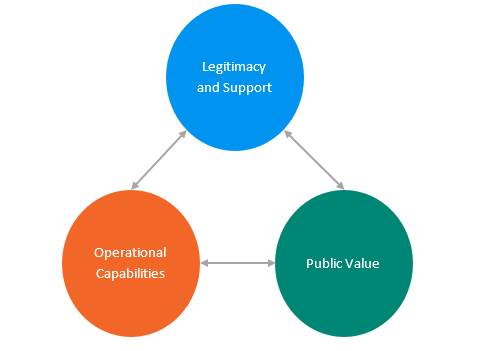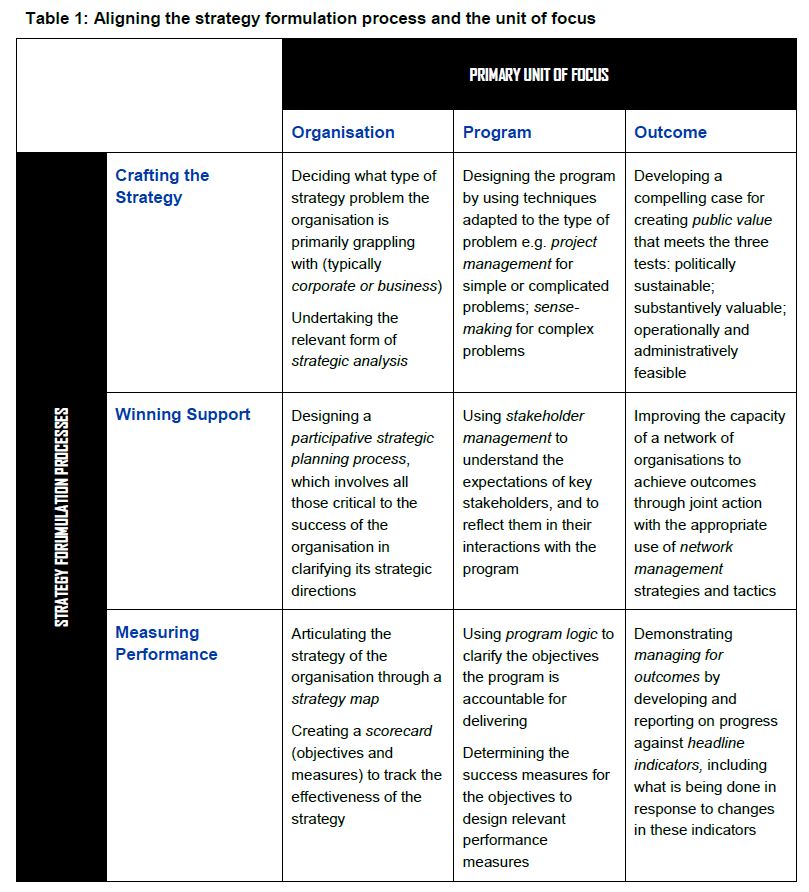Module 1: Strategy and Governance
Topic 1.1: Strategy and Public Sector Value
The main themes to be explored in this topic are: strategy, value and governance in the public sector.
- Value within and delivered by organisations means something tangible or intangible, that has worth and/or meaning to something or someone – people, teams, systems, organisations.
- Strategy is typically a set of developed and deliberate actions, processes and expectations that ideally result in desired and beneficial long-term organisational outcomes.
- Governance encompasses the systems and structures by which an organisation is directed, controlled and operated and the mechanisms by which it and the people within it are held to account.
Here is more detail about these key concepts and how they interact.
What Is Value
Organisations exist to do and achieve something, and the something should be of value to someone, something, or some collective. Value implies that the something has meaning, is useful, has relevance, and ideally is important and ongoing, to those who receive or benefit from it.
To deliver value, resources are expended, effort exerted, and expertise utilised, and ideally, new knowledge created, shared and made explicit!
To ‘have’ value, implies that it can be measured, estimated or calculated, and that there is some ‘outcome’ that is the result of conscious activity. Some examples are ‘adding value’, ‘delivering value’, ‘measuring value’, and ‘communicating value’.
The concept of shared value
Value in the private sector is often in terms of hard assets, currency, stocks, land title etc., and that individuals and entities own the outcomes. It is apparent as well that societies benefit when value is shared, and when outcomes are more beneficial to more stakeholders.
The Harvard Business School strategy guru, Michael Porter, after many years researching and consulting in the corporate world, began to speak of shared value – the concept that businesses must create business value in a way that also creates value for society, in a manner that enhances social processes, and addresses societies’ needs and challenges (Porter and Kramer, 2011)[1]. Whether or not you agree, his premise also encompasses the role of government – his claim being that governments have a crucial role in enabling shared value, by regulating and delivering in ways that enhance rather than detract from value-generation systems.
Public sector value
Hence the concept of Public Sector Value which you explored in GSZ631 Managing within the Context of Government. What actually is ‘public sector value’? In this module, we will consider public sector value to encompass public organisations (includes entities such as NGOs and non-profits), outputs (the products and services produced by the organisation), the outcomes (the impacts of as a result of the value – product/service), and the meaning of the value for those who enjoy or benefit from it (Alford and O’Flynn, 2013)[2].
Mark Moore and Sanjeev Khagram (2004)[3] have led a crucial movement that is focused on exploring, understanding and embedding a mindset that is focused on delivering explicit public sector value. Their work has been highly influential in helping frame the context and create a shared language. Following are the three core questions that underpin their focus and that seek to embed strategic principles in the public sector:
- What is the ‘public value’ the organisation is seeking to produce?
- What are the sources of legitimacy and support that can ‘authorise’ the organisation to take action and provide resources to sustain the effort to create that value?
- What are the operational capabilities the organisation needs or would rely on to achieve the desired results?
Moore and Khagram combine these three concepts into a ‘strategic triangle’ (2004:3).
Figure 1.1 The Strategic Triangle.
Public sector leaders and managers essentially tell the story of value creation to elected representatives of the people in legislatures and executive branches positions (Moore and Khagram, 2004, p.5). Note the concept of authorising environments – the number and variety of people in particular positions who authorise them to take action, appropriate money, or act on their behalves.
The authorisers in the public sector environment – the elected representatives of the people and those who influence them – have wide and varied needs, wants and expectations. These might include low costs both as users and as contributors via taxes, low administrative costs, quality outcomes etc. However, in the public sector, the authorising environment is often the only source of funds and resources. The challenge then is to satisfy the authorisers by being seen to deliver something of value.
Required
15 mins
- Is it the job of the public sector manager to create public value?
- What do your work colleagues think about this?
- How explicit is the concept of public value, in your current work environment?
Why ‘strategy’?
What do public sector managers actually ‘do’, how do they know what to do, and how will they know when they have achieved what they were expected to do? Let’s return to the strategic triangle. Strategy in the public sector and similar contexts, must seek to achieve something that is of value and contributes to the public domain; it must be legitimate and sustainable (including politically), and it must be operationally and administratively possible (Moore 1995)[4].
Exploring Interactions
Overall, the implications are that public sector managers operate within the agency’s overarching strategy, are mindful of the various sets of dynamics, tensions, and prevailing imperatives, including public sector governance, public sector value and public sector values. They develop and oversee tactical and operational programs, projects and initiatives to deliver on the agency’s overall objectives.
According to Petris (2010)[5], the following principles apply to devising strategy:
- Crafting the strategy through analysis and environmental sensing.
- Winning support from the ‘authorising environment’ – the Minister, Cabinet, and/or the broader community.
- Measuring the performance after determining success factors.
Having set the ‘context’ of strategy next is the execution of strategy. This entails the concept of strategic alignment, which is a key component and a crucial starting point for success in achieving strategic outcomes.
Required
40 min
Application to Workplace Project
Referring to the Strategic Triangle diagram, and what you have learned from the Torfing reading:
- Make a short list of the operational capabilities, the authorizing environment (legitimacy and support) and the potential public value possibilities.
-
- To what degree do these impact and potentially enable your Workplace Project?
Related to these principles of understanding the environment, building support, and measuring outcomes against expectations, managers need to develop effective skills that include:
- The need to understand and manage the ‘business’ of government;
- The need to think systemically in an ambiguous and competitive environment;
- Building systems, processes and people that are enabled to deliver on productivity and performance imperatives, as well as being accountable and holding others to account in that context; and
- Managing the web of stakeholder involvement, including ‘customers’, clients, suppliers, voters, the community, etc.
Since strategy is enacted largely by people, or by systems and processes that have people as the focus and the drivers, then public sector managers and those who operate in the public value domain, need to have the above skills included in their overarching set of capabilities. You will have explored these skills in your previous units, and will practice in this unit in the context of the operational environment.
Recommended
40 mins
When designing interventions to tackle strategy formulation challenges, public sector managers will often have more than one objective. Take a moment to explore the following table (Petris, 2010), and then consider the steps that are essential in the current government and NGO contexts.
For example, the Crafting the Strategy-Organisation box suggests that the strategy team should design a participative planning process. Ideally the team would create a process to fit the culture and working style of the context.
Table 1: Aligning the strategy formulation process and the unit of focus (Petris, 2010)
Please see Appendix 1: Useful Definitions. It contains definitions for some of the many concepts that are relevant to the strategy field. Please add to the table any definitions and concepts that are relevant and specific to your jurisdiction and agency.
- Porter, M. & Kramer, M. (2011). Creating Shared Value: How to Reinvent Capitalism – and unleash a wave of innovation and growth. Harvard Business Review, 63-70. ↵
- Alford, J. & O’Flynn, J. (2013). Making Sense of Public Value: Concepts, Critiques and Emergent Meanings. International Journal of Public Administration, 32(3-4), 171-191. ↵
- Moore, M. & Khagram, S. (2004). On Creating Public Value: What Business Might Learn from Government about Strategic Management (Corporate Social Responsibility Working Paper 3). Cambridge, MA: John F. Kennedy School of Government Responsibility, Harvard University. ↵
- Moore, M. (1995) Creating public value: Strategic management in government, Cambridge, MA. Harvard University Press. ↵
- Petris, S. (2010). Occasional Paper No.7: The nature of strategy in the public sector. The Australia and New Zealand School of Government. ISBN 978-1-921337-86-4 ↵


